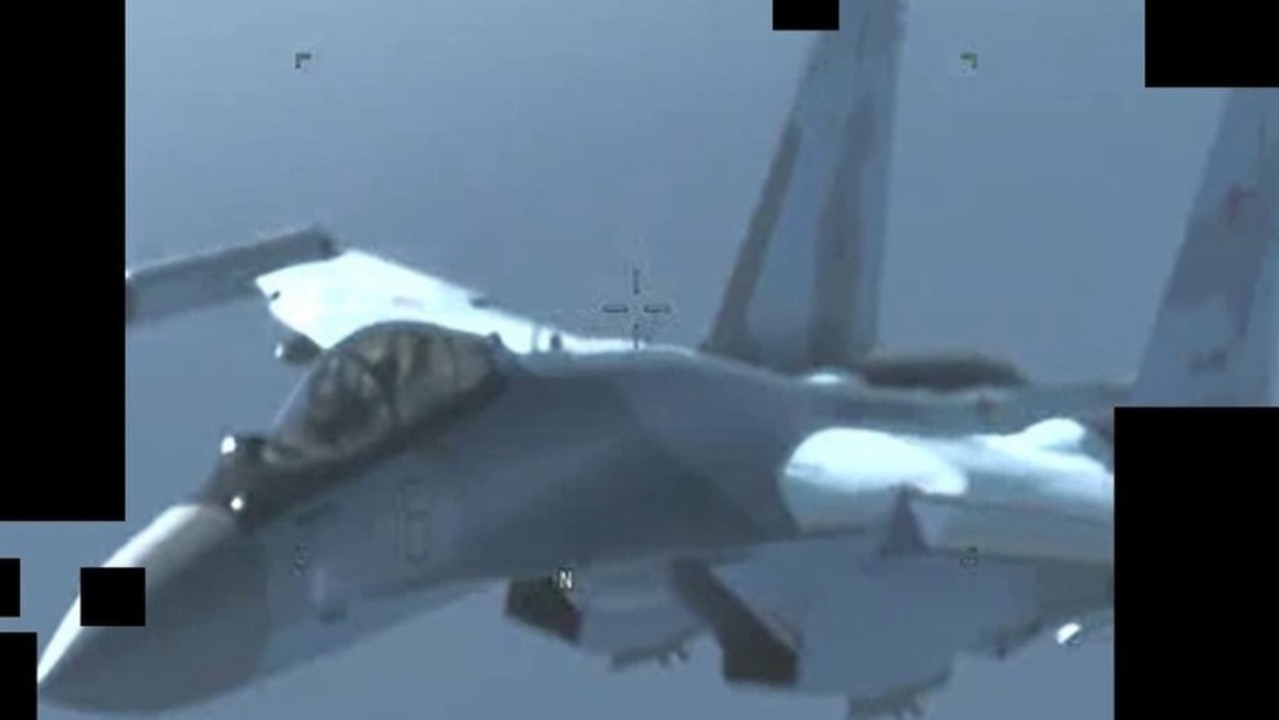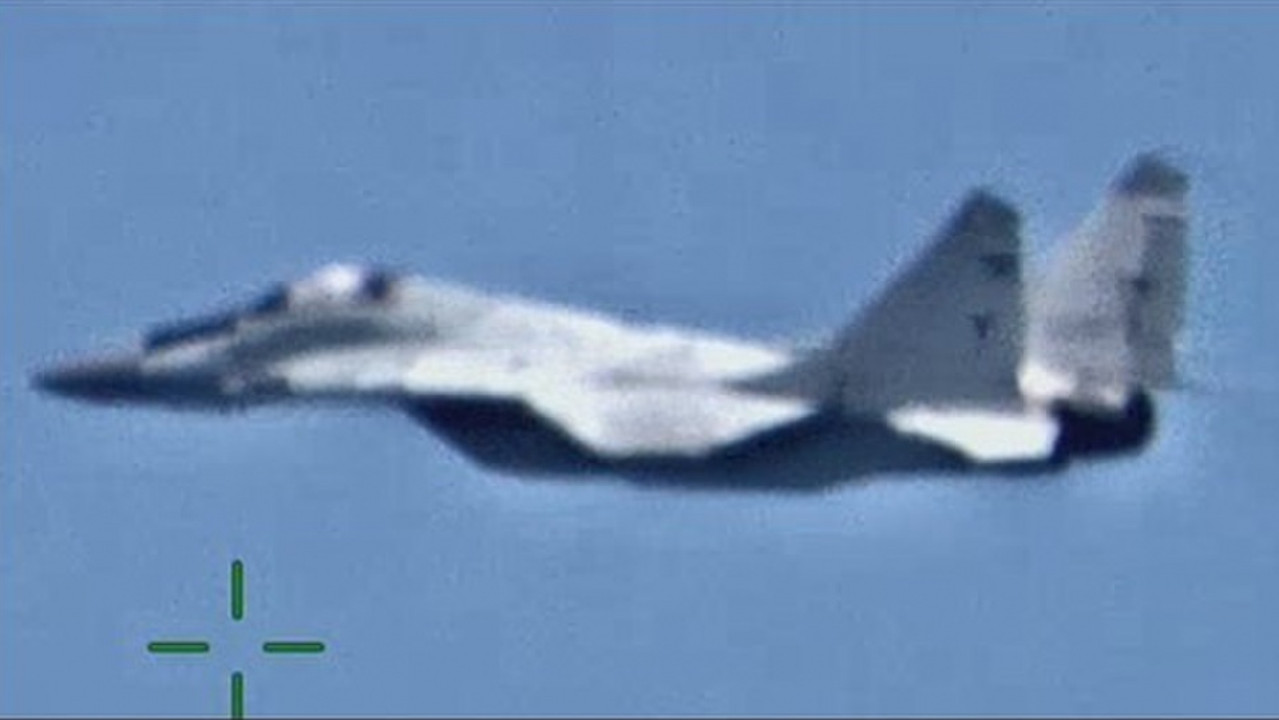Putin’s ‘big lie’ about Moscow’s intervention in Libya
Russian advanced combat jets were tracked every step of the way on their latest journey but officials are denying it ever happened. Why?
There’s power in chaos, confusion, and lies.
They give unwilling participants the opportunity to quietly ignore a crisis.
It’s a central part of what analysts call “The Grey Zone” – aggressive international interventions that dodge serious repercussions through implausible deniability.
The United States military commander for the African theatre has confirmed Russia has sent a powerful force of MiG-19 Fulcrum fighters and Su-24 Fencer bombers into Libya.
It’s just Moscow’s latest military intervention in the Mediterranean region.
The combat aircraft were tracked en route from Russia using open-source intelligence gathering systems – such as commercial satellite photographs.
Despite the evidence, Moscow insists it never happened. Any claims it did, one chief minister insists, are “stupidity”.
Moscow-backed Libyan forces are parroting this hard-line denial. Its official spokesman insists no jets have been delivered, and any report that they have is “media rumours and lies”.
RELATED: Russian and US forces clash in Libya
‘FAKE NEWS’
International analysts have been pouring over evidence of this major deployment for the past week. They’ve been watching unusual movements and work around Libyan air bases. They’ve been tracking Russian aircraft movements. They’ve connected the dots.
Commercial satellite photos revealed distinctive-looking Fulcrums and Flankers parked in temporary open dispersal bays at Russia’s Khmeimim Air Base in Syria on May 18. Fulcrums do not form part of the permanent force maintained there.
MiG-29 fighters were at Russia's air base in Syria just before showing up in Libya:https://t.co/LW1l2vNlgy
— Tyler Rogoway (@Aviation_Intel) May 26, 2020
The combat jets then had to fly some 2100km to reach Libya’s Al Jufrah air base.
This is well beyond the reach of their fuel loads.
But evidence has emerged that they were escorted by other Russian aircraft across the Mediterranean before landing to refuel near Tobruk.
According to the #US #Africa Command, the military hardware is to support Russian state-sponsored private military contractors (PMCs) operating on the ground in Libya. #Turkey #UAE #Egypt pic.twitter.com/ExmHhsT1oj
— ImageSat Intl. (@ImageSatIntl) May 27, 2020
The warplanes have since been observed on the ground at the heavily fortified Al Jufra Air Base in central Libya. That’s a stronghold of Moscow-backed rebels.
US Africa military command (AFRICOM) has now come out in support of these claims. It says it observed the Fulcrum and Fencer aircraft arriving in Syria wearing Russian Federation air force markings.
NEWS: Russia deploys military fighter aircraft to Libya
— US AFRICOM (@USAfricaCommand) May 26, 2020
-----
"For too long, Russia has denied the full extent of its involvement in the ongoing Libyan conflict. Well, there is no denying it now." - Gen. Townsend
Release: https://t.co/HpLdwUJxcr
Photos: https://t.co/raTal1LKPa pic.twitter.com/dVtsWKPYZ5
Only after they landed in Syria were they repainted to conceal their origins.
“For too long, Russia has denied the full extent of its involvement in the ongoing Libyan conflict. Well, there is no denying it now,” US military commander General Stephen J. Townsend said in an official statement.
“We watched as Russia flew fourth-generation jet fighters to Libya — every step of the way.”
But Russia is denying it.
POKER FACED
“If the warplanes are in Libya, they are Soviet, not Russian,” Kremlin defence committee chief Viktor Bondarev insists.
It’s demonstrably not true. But it holds the minimal degree of plausibility.
Both types of combat jet do have their origins in 1980s Soviet Russia.
It’s just that Libya never owned any. And claims that “mercenary” forces are able to purchase, upgrade, maintain, deploy and fly such large numbers of these complex weapons systems at a moment’s notice are … extraordinary.
They are flown by Russian military members & escorted by Russian fighters based in Syria to Libya, landing in Eastern Libya near Tobruk for fuel. At least 14 newly unmarked Russian aircraft are then delivered to Al Jufra Air Base in Libya. (2/2) pic.twitter.com/bB9g66pVUc
— US AFRICOM (@USAfricaCommand) May 27, 2020
Extraordinary claims require extraordinary evidence.
All the evidence points back to Moscow itself.
“What this injection of Russian air power really does is it shores up Russia's negotiating position with Turkey over a political settlement that gives Russia access to this oil-rich African country,” says Carnegie Endowment analyst Andrew Weiss.
“Meanwhile, the US has been on the sidelines. There have been some very strong US statements, but that's not going to be enough to deter future Russian adventurism.”
Analysts say there is a pattern to this behaviour. And it’s largely based on a lack of consequences.
“We’ve seen a much wider pattern of Russian opportunism across both the Middle East and other parts of the world far from Russia's direct borders,” Weiss says. “The question is, what’s prompting this? There’s a higher risk appetite in the Kremlin to fill vacuums and take advantage of retrenchment, and to basically create facts.
“It’s hard to embarrass the Kremlin. It’s been able to pull off significant military gains on the cheap. Simply shaming them or trying to embarrass them is not going to form a Russian retreat.”

LIBYAN CRISIS
Libya has been wracked by civil war ever since NATO-backed an uprising against dictator Muammar Gaddafi in 2011.
Now, the Moscow-backed forces of self-proclaimed Field Marshal Khalifa Haftar’s have suffered a serious defeat. The Libyan National Army (LNA) assault on the capital Tripoli – which was supposed to be their crowning victory – was repulsed.
This was despite the presence of large numbers of heavily-equipped and well-trained Russian troops among their ranks, including sniper and missile units along with drone operators. The Russian-led international coalition includes support from France, Egypt, Jordan and the United Arab Emirates.
Standing against them is the United Nations-backed Libyan Government of National Accord (GNA). NATO-member Turkey last year arbitrarily sent its own forces to back Haftar, including troops, drones and artillery. Qatar and Italy have also been backing Prime Minister al-Sarraj.
This support has turned the tide against Haftar.
And that has serious implications for Moscow.
Which is why the Kremlin felt the need to escalate and send in combat jets.
As for the United States, it’s no longer clear exactly which faction it backs. Initially, it was the GNA’s Prime Minister al-Sarraj. But, last year, President Donald Trump suddenly overruled his State Department and ordered his forces to back Mr Putin’s favourite instead.
Mr Trump “recognised Field Marshal Haftar’s significant role in fighting terrorism and securing Libya’s oil resources, and the two discussed a shared vision for Libya’s transition to a stable, democratic political system,” the surprise White House statement read.
But the US State Department later reasserted its “support for Libya’s sovereignty and territorial integrity in the face of Russia’s attempts to exploit the conflict against the will of the Libyan people”.

GREY WARRIORS
The Wagner Group that has taken delivery of these combat jets is purportedly a privately owned and operated mercenary force. But it has been repeatedly shown to have unusually strong ties to Russian intelligence agencies and even senior Kremlin officials.
It was at the core of a bloody clash with US forces in Syria in 2018. Several hundred Russian troops were believed killed. It also has been fighting in Libya now for several years, where it has some 800 and 1200 Russian nationals on the ground.
Moscow has a history of disguising its troops as mercenaries.
PMC Wagner column somewhere in #Libya pic.twitter.com/mBwERyCINH
— Aldin 🇧🇦 (@aldin_ww) May 27, 2020
It used special forces troops with their badges and markings removed to invade Crimea in 2014. Since then, Russian regular army troops have been repeatedly observed fighting with frontline Russian military equipment – including tanks – inside Ukraine. Moscow insists these are “volunteers”.
In 2015, it sent a powerful force of strike aircraft – backed by troops, tanks and ships – into Syria to prop-up the beleaguered government of Bashar al-Assad. The nation’s decade-long civil war has since swung back dramatically in his favour.
Mr Putin has repeatedly declared the full withdrawal of these forces since then. Yet they remain.
MiG-29 on the ground at al-Jufrah, 19 May 20. Grid: 29.1916, 16.0112 https://t.co/62By0rSZMC pic.twitter.com/k1Fw7HePOA
— Brian Castner (@Brian_Castner) May 21, 2020
Naturally, sticking to a big lie is virtually impossible. But that doesn’t matter to Moscow.
Despite flatly denying the arrival of the aircraft, Haftar’s forces have not been able to resist boasting. “You are about to see the largest aerial campaign in Libyan history in the coming hours,” one official statement declared.
And this is by no means the only example.
“The world (has now) heard Mr Haftar declare he was about to unleash a new air campaign. That will be Russian mercenary pilots flying Russian-supplied aircraft to bomb Libyans,” General Townsend said.
Jamie Seidel is a freelance writer | @JamieSeidel




